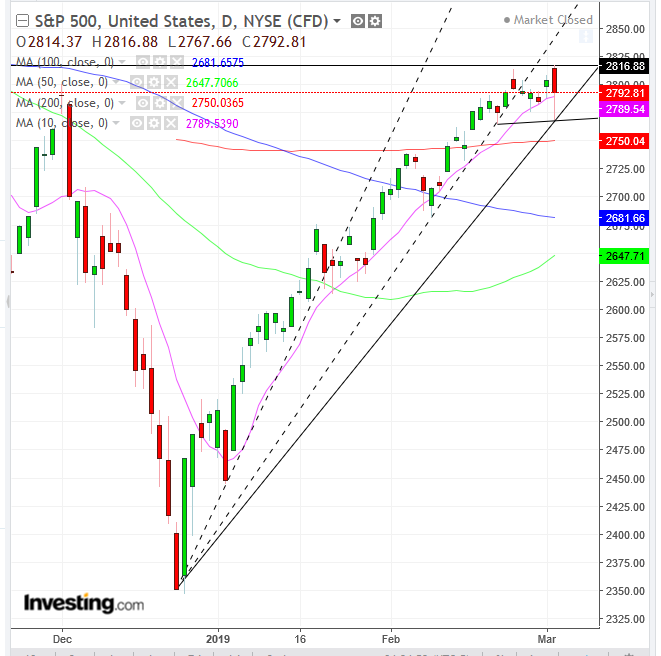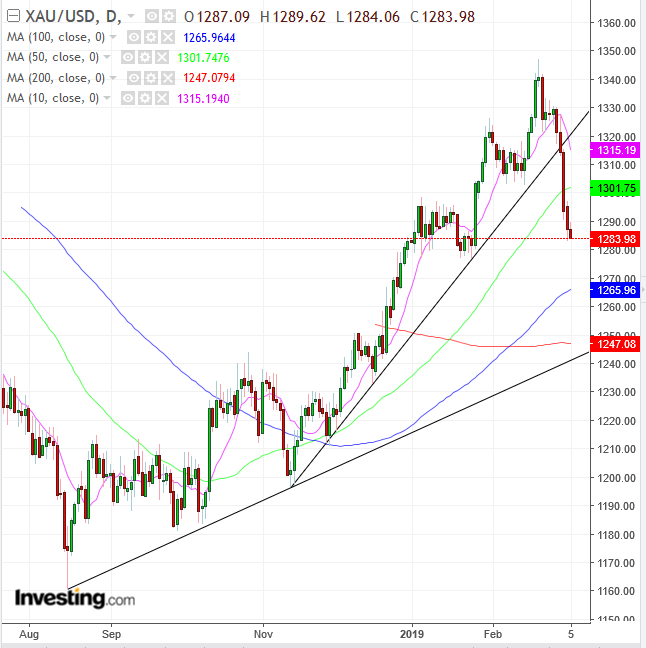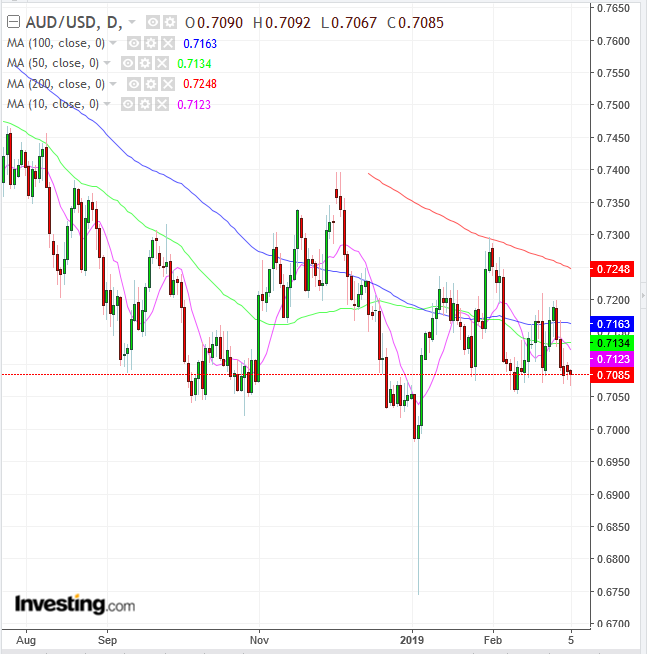- European shares slip, U.S. futures waver after China unveils plans to boost sagging growth
- Yields edge higher as investors take on more risk
- Gold sells off on correction; Aussie sells off amid stagnant monetary policy
Key Events
Futures on the S&P 500, Dow and NASDAQ 100 and European shares struggled to gain ground this morning following a mixed Asian session, as the market weighed the potential impact of tax cuts and a lower growth outlook in China amid growing hopes for a trade deal.
The STOXX 600, initially falling alongside automakers, rebounded with telecommunications but later resumed its decline. Technically, should prices tick higher, they would advance for a fourth straight day. Right now, the uptrend needs to prove it can overcome the presumed resistance of Monday’s shooting star. Meanwhile, the 50 DMA crossed over the 100 DMA, as the more recent price average has improved over long-term pricing.
In the earlier Asian session, China’s Shanghai Composite (+0.88%) climbed for a third straight day as trade optimism as well as $298 billion in tax cuts and infrastructure spending plans to boost growth—unveiled by government officials on Tuesday—offset weaker growth forecasts and the “hard struggle” ahead Premier Li Keqiang warned against at the opening of the parliament's annual meeting.
Technically, the 50 DMA is over the 100 DMA, but today’s price action failed to overcome yesterday’s potent shooting star, whose upper shadow was exceptionally long. Yesterday’s price reached the highest level since June on trade hopes. Bears pushed back, forming the shooting star, on slower growth expectations.
The question is whether the newly-announced tax cuts will materialize into growth and whether trade talks will yield a substantial deal. If they do, it will become clearer whether the trade war was the critical headwind it was characterized to be in the market's narrative. The inconsistencies we have been discussing for months—including, in times of improving trade outlook, small caps outperforming instead of lagging and Treasurys and gold gaining ground instead of edging lower—have raised a red flag.
Hong Kong’s Hang Seng (+0.01%) found support on the 10 DMA to barely close in green territory. Except for a single lower close on Feb. 15, the MA supported price since scaling higher on Jan. 7. After the 50 DMA recently crossed above the 100 DMA, it is nearing the 200 DMA. On the other hand, yesterday’s shooting star confirmed Feb. 25th’s hanging man, authenticated the next day with a close that encroached into the long, green candle two sessions earlier.
Japan’s Nikkei 225 (-0.44%) filled half of yesterday’s rising gap, which closed as a high-wave candle.
South Korea’s KOSPI (-0.52%) dropped for a third day, as North Korea leader Kim Jong Un returned home from the failed U.S.-NK summit, which stepped short of yielding any nuclear agreement and, by extension, to reduce uncertainty in the region. Technically, the price found resistance by the 200 DMA, even after the 50 DMA crossed above the 100 DMA. That MA interplay—an apparent price acceleration turning into a deceleration—is typical of a market top, as can be visually represented by a potential H&S top in the making.
Australia’s S&P/ASX 200 retreated 0.29% from a four-day straight advance.
Global Financial Affairs
In yesterday’s U.S. session, stocks sold off as impatient investors became less optimistic about a trade war resolution due to the lack of details on the reported U.S.-China deal.

The S&P 500 (-0.39%) was dragged lower by Health Care (-1.36%) and Financials (-0.64%), whose losses overshadowed a climb in Materials (+0.45%) and Real Estate (+0.4%). Technically, the price extended the short-term uptrend, posting a new intraday high above the 2,800 round-number and reaching the highest level since Oct. 17. The price penetrated—but closed below—the 10 DMA, which has been supporting the price with no lower closes since Jan. 3. However, the higher peak was followed by a sharp, volatile fall, typical of a market top, as the price congestion since Feb. 26 has been forming the first half of a potential H&S top.
The Dow slipped 0.79%. The NASDAQ Composite gave up 0.23% and the Russell 2000 (-0.85%) underperformed amid signs of a resolving trade deal—which would benefit stocks of multinational firms.
Meanwhile, yields on 10-year Treasurys pared some of yesterday’s slide—which had been spurred by greater demand for bonds—as investors seemed to be willing to take on more risk.

Gold was dropping for the fifth straight session, after reaching the upward targets we have repeatedly set out over the past months. It seems that it’s time for a correction, toward the medium-term uptrend line since August, supported by the 200 DMA below $1,250. Fluctuating sentiment over the U.S.-China trade dispute has also weighed on the yellow metal, with the U.S. dollar becoming investors' preferred hedge against trade jitters.
Japan's safe-haven currency also slid, while the greenback ticked higher for a fifth straight session.

The Australian dollar fell to a three-week low after the Reserve Bank of Australia left its benchmark interest rate unchanged. Technically, the price is reaching the bottom of a congestion since early October, which could be the catalyst for a strong move to follow.
Up Ahead
- RBA Governor Philip Lowe gives a speech on Australia's housing market on Wednesday.
- Bank of Canada is expected to keep rates on hold on Wednesday due to lingering uncertainty on housing and investment, though Governor Stephen Poloz is expected to stick to his message that borrowing costs eventually need to head higher.
- European Central Bank policy makers are expected to leave rates unchanged on Thursday, amid a deteriorating economic outlook. President Mario Draghi will hold a news conference after the decision.
- The U.S. jobs report coming out on Friday may show hiring subsided in February. Nonfarm payrolls are forecast to have increased by 185,000 and the jobless rate to have slipped to 3.9 %.
Market Moves
Stocks
- The STOXX 600 declined 0.1 percent.
- Futures on the S&P 500 edged 0.1 percent higher.
- The U.K.’s FTSE 100 rose less than 0.05 percent to the highest in a week.
- Germany’s DAX dropped 0.1 percent.
- The MSCI Emerging Market Index ticked 0.1 percent higher.
- The MSCI Asia Pacific Index fell 0.3 percent.
Currencies
- The Dollar Index edged 0.1 percent higher, hitting the highest in almost three weeks with its fifth straight advance for a total gain of 0.77%.
- The euro slid 0.2 percent to $1.1318, the weakest in more than two weeks.
- The British pound fell less than 0.05 percent to $1.3174, the weakest in more than a week.
- The Japanese yen dropped 0.2 percent to 111.94 per dollar, the weakest in almost 11 weeks.
Bonds
- The yield on 10-year Treasurys rose one basis point to 2.73 percent.
- Germany’s 10-year yield increased one basis point to 0.17 percent.
- Britain’s 10-year yield gained one basis point to 1.283 percent.
- Italy’s Italy 10-year yield climbed one basis point to 2.745 percent.
Commodities
- West Texas Intermediate crude slipped 0.3 percent to $56.41 a barrel.
- Gold fell 0.2 percent to $1,284.73 an ounce, reaching the weakest in almost six weeks on its fifth consecutive decline.
Which stock should you buy in your very next trade?
AI computing powers are changing the stock market. Investing.com's ProPicks AI includes 6 winning stock portfolios chosen by our advanced AI. In 2024 alone, ProPicks AI identified 2 stocks that surged over 150%, 4 additional stocks that leaped over 30%, and 3 more that climbed over 25%. Which stock will be the next to soar?
Unlock ProPicks AI